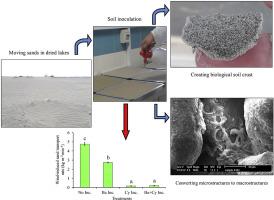当前位置:
X-MOL 学术
›
Eur. J. Soil Biol.
›
论文详情
Our official English website, www.x-mol.net, welcomes your
feedback! (Note: you will need to create a separate account there.)
Stabilizing sand from dried-up lakebeds against wind erosion by accelerating biological soil crust development
European Journal of Soil Biology ( IF 3.7 ) Pub Date : 2020-05-01 , DOI: 10.1016/j.ejsobi.2020.103189 Hossein Kheirfam , Farrokh Asadzadeh
European Journal of Soil Biology ( IF 3.7 ) Pub Date : 2020-05-01 , DOI: 10.1016/j.ejsobi.2020.103189 Hossein Kheirfam , Farrokh Asadzadeh

|
Abstract Land degradation and the resulting desertification often lead to sand flowing from deserts and/or dried-up lakebeds and into habitable zones; a problem that has intensified in recent decades. We cultivated locally collected biological soil crust (BSC) bacteria (Bacillus subtilis strain) and cyanobacteria (Nostoc sp. and Oscillatoria sp.) from the dried-up bed of Lake Urmia, northwest Iran. To evaluate the ability of BSC to stabilize the sandy lakebed soil, bacteria and cyanobacteria were used to inoculate experimental trays of sandy soil from the same area, under laboratory conditions. After 120 days, we simulated winds at a speed of 72 km h−1 for three 10-min intervals (30 min in overall) to measure the sand transport rate as well as the durability and fragility of the BSCs during the wind erosion process, using an open circuit wind tunnel. We found that the bacteria, cyanobacteria, and cyanobacteria + bacteria inoculation reduced the sand flowing by 42.3, 96.6, and 95.9%, respectively, as compared to the control. We found that in addition to creating a protective cover on the soil surface, cyanobacteria created a strong bond between the soil particles through their exudation of exopolysaccharides and network of filaments, increasing the ability of the sand to withstand wind forces. Our inoculation technique was an effective and natural way to stabilize moving sand. Future research should replicate our methods under natural conditions to evaluate the potential for large-scale restoration.
中文翻译:

通过加速生物土壤结皮发育来稳定干涸湖床中的沙子以防止风蚀
摘要 土地退化和由此导致的荒漠化常常导致沙子从沙漠和/或干涸的湖床流入宜居带;近几十年来愈演愈烈的问题。我们从伊朗西北部乌尔米亚湖干涸的河床中培养了当地收集的生物土壤结皮 (BSC) 细菌(枯草芽孢杆菌菌株)和蓝细菌(Nostoc sp. 和 Oscillatoria sp.)。为了评估 BSC 稳定沙质湖床土壤的能力,在实验室条件下,使用细菌和蓝藻接种来自同一地区的沙质土壤的实验托盘。120 天后,我们以 72 km h-1 的速度模拟了三个 10 分钟间隔(总共 30 分钟)的风,以测量沙子运输速率以及风蚀过程中 BSC 的耐久性和脆弱性,使用开路风洞。我们发现,与对照相比,细菌、蓝细菌和蓝细菌 + 细菌接种使沙子流动分别减少了 42.3、96.6 和 95.9%。我们发现,除了在土壤表面形成保护层外,蓝藻还通过胞外多糖和细丝网络的渗出在土壤颗粒之间建立了牢固的结合,从而增加了沙子抵御风力的能力。我们的接种技术是一种稳定流动沙子的有效且自然的方法。未来的研究应该在自然条件下复制我们的方法,以评估大规模恢复的潜力。与对照相比。我们发现,除了在土壤表面形成保护层外,蓝藻还通过胞外多糖和细丝网络的渗出在土壤颗粒之间建立了牢固的结合,从而增加了沙子抵御风力的能力。我们的接种技术是一种稳定流动沙子的有效且自然的方法。未来的研究应该在自然条件下复制我们的方法,以评估大规模恢复的潜力。与对照相比。我们发现,除了在土壤表面形成保护层外,蓝藻还通过胞外多糖和细丝网络的渗出在土壤颗粒之间建立了牢固的结合,从而增加了沙子抵御风力的能力。我们的接种技术是一种稳定流动沙子的有效且自然的方法。未来的研究应该在自然条件下复制我们的方法,以评估大规模恢复的潜力。我们的接种技术是一种稳定流动沙子的有效且自然的方法。未来的研究应该在自然条件下复制我们的方法,以评估大规模恢复的潜力。我们的接种技术是一种稳定流动沙子的有效且自然的方法。未来的研究应该在自然条件下复制我们的方法,以评估大规模恢复的潜力。
更新日期:2020-05-01
中文翻译:

通过加速生物土壤结皮发育来稳定干涸湖床中的沙子以防止风蚀
摘要 土地退化和由此导致的荒漠化常常导致沙子从沙漠和/或干涸的湖床流入宜居带;近几十年来愈演愈烈的问题。我们从伊朗西北部乌尔米亚湖干涸的河床中培养了当地收集的生物土壤结皮 (BSC) 细菌(枯草芽孢杆菌菌株)和蓝细菌(Nostoc sp. 和 Oscillatoria sp.)。为了评估 BSC 稳定沙质湖床土壤的能力,在实验室条件下,使用细菌和蓝藻接种来自同一地区的沙质土壤的实验托盘。120 天后,我们以 72 km h-1 的速度模拟了三个 10 分钟间隔(总共 30 分钟)的风,以测量沙子运输速率以及风蚀过程中 BSC 的耐久性和脆弱性,使用开路风洞。我们发现,与对照相比,细菌、蓝细菌和蓝细菌 + 细菌接种使沙子流动分别减少了 42.3、96.6 和 95.9%。我们发现,除了在土壤表面形成保护层外,蓝藻还通过胞外多糖和细丝网络的渗出在土壤颗粒之间建立了牢固的结合,从而增加了沙子抵御风力的能力。我们的接种技术是一种稳定流动沙子的有效且自然的方法。未来的研究应该在自然条件下复制我们的方法,以评估大规模恢复的潜力。与对照相比。我们发现,除了在土壤表面形成保护层外,蓝藻还通过胞外多糖和细丝网络的渗出在土壤颗粒之间建立了牢固的结合,从而增加了沙子抵御风力的能力。我们的接种技术是一种稳定流动沙子的有效且自然的方法。未来的研究应该在自然条件下复制我们的方法,以评估大规模恢复的潜力。与对照相比。我们发现,除了在土壤表面形成保护层外,蓝藻还通过胞外多糖和细丝网络的渗出在土壤颗粒之间建立了牢固的结合,从而增加了沙子抵御风力的能力。我们的接种技术是一种稳定流动沙子的有效且自然的方法。未来的研究应该在自然条件下复制我们的方法,以评估大规模恢复的潜力。我们的接种技术是一种稳定流动沙子的有效且自然的方法。未来的研究应该在自然条件下复制我们的方法,以评估大规模恢复的潜力。我们的接种技术是一种稳定流动沙子的有效且自然的方法。未来的研究应该在自然条件下复制我们的方法,以评估大规模恢复的潜力。











































 京公网安备 11010802027423号
京公网安备 11010802027423号